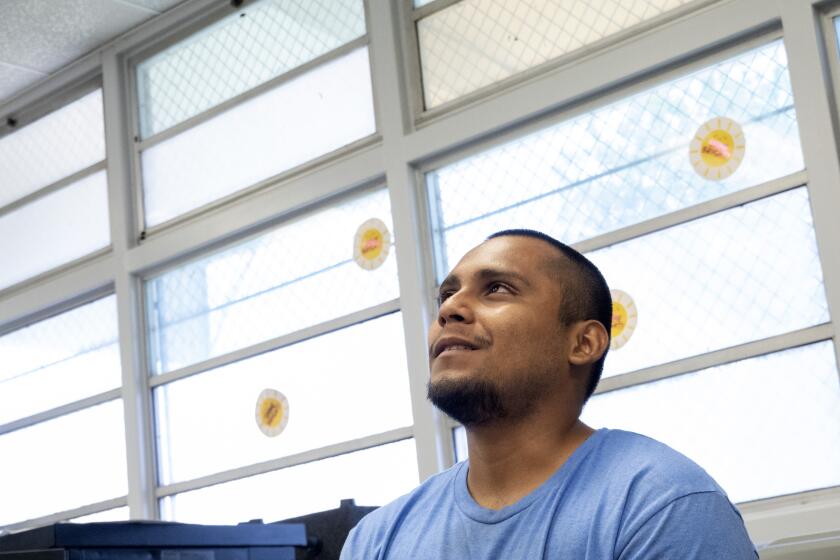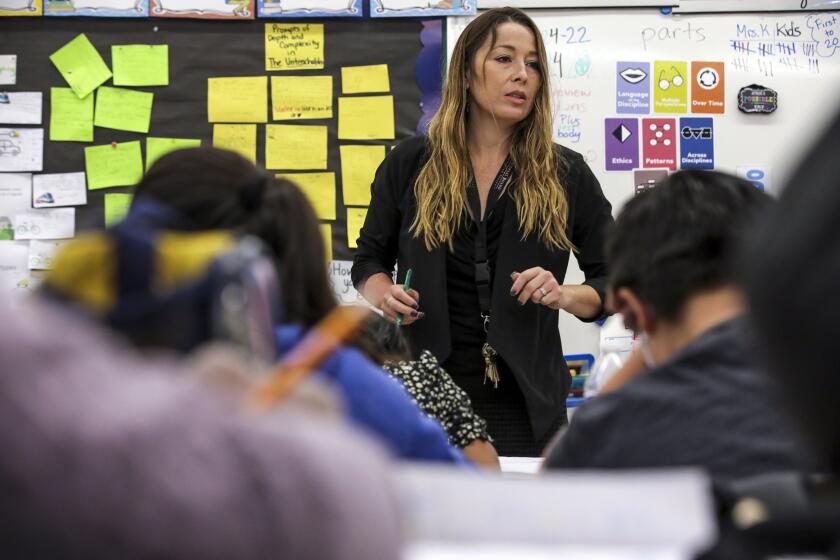Worst national reading and math scores in decades show large pandemic-fueled equity gaps

- Share via
National reading and math test scores of 9-year-olds released Thursday revealed alarming trends about the extent of the pandemic’s negative effect on learning, with scores showing the steepest declines in decades and the biggest drops among children who were already academically struggling.
The declines and wide equity gaps come as Los Angeles Unified Supt. Alberto Carvalho said he has reviewed unreleased state tests scores in the nation’s second-largest school district that “show devastating loss in terms of student achievement levels, particularly in reading and mathematics.”
Average math scores on the National Assessment of Educational Progress tests fell 7 points to 234 on a 0-500 scale. For students performing in the bottom 10%, the drop was 12 points, compared with 3 points for those in the top 10%.
Average reading scores fell 5 points to 215. Students performing in the lowest 10% lost 10 points. The top 10% of test takers lost about 2 points.
“That’s five times the rate of loss in reading,” Carvalho noted.
The declines and wide equity gaps also will be reflected locally, Carvalho said.
“There has been a truly historic decrease in performance,” said Carvalho, who sits on the governing board for the tests, known as the nation’s report card. “So whether you look at reading or mathematics, this is obviously a grave concern, particularly when you disaggregate the data. Why? When you disaggregate the data, the most severe performance loss or decreases we’re seeing are experienced by the lower-performing students.”
The drop in math scores was the first decline since the tests began to be administered in the 1970s. The reading decline was the largest in 30 years.
Experts say the results point to a crisis among American schoolchildren.
An influx of billions of dollars of state funding is aimed at addressing the crisis, but the need is urgent.
“What I worry is that there is the risk that the already underachieving students now will never be able to catch up,” said Li Cai, professor of education at UCLA. “That over time they will never be able to match the achievement of those students that may have been born into luckier circumstances.
“We have to ask ourselves, is that something we want as a society?” Cai added.
The scores offer the first look with a national sample comparing where students were earlier this year to where they were just before the COVID-19 pandemic was declared in 2020.
The scores showed significant variations by racial and ethnic student groups.
For example, in math, white student scores fell 5 points, Latino scores fell 8 points and Black student scores fell 13 points. In reading, white, Black and Latino students all declined 6 points.
Scores for Asian students and Native American students were not measurably different.
As part of the data collection, researchers also asked about student access to learning opportunities. The results point to stark inequities in the ways students experienced school closures.
More than 80% of remote-learning students performing at or above the 75th percentile had access to a desktop computer, laptop or tablet all the time. Only about 60% of students in the bottom 25th percentile had the same access.
Sixty percent of higher-performing students in math said their teacher was available to help with schoolwork at least once or twice a week. Only 39% of lower-performing students said the same.
The tests reflect the performance of 9-year-olds, who are typically in third and fourth grade — a crucial time of learning.
“It’s when a lot of those foundational skills need to be in place to start increasing academic rigor,” said Heather Hough, executive director of the research center Policy Analysis for California Education. “For students who are really behind in third grade, who don’t have basic literacy and numeracy, it can be really hard to catch up.”
Additional National Assessment of Educational Progress results for the nation, states and 26 urban school districts — including Los Angeles and San Diego — are expected to be released later this year.
The results released Thursday clarify a picture that has been emerging for some time through state and local data about the adverse effect of the pandemic and remote learning on education.
Students with resources — such as good internet access and support from caregivers — were often able to pivot more easily to virtual school. Students lacking support and resources constantly struggled to connect online, often had to care for younger siblings or work to help support their family, and couldn’t get the extra tutoring they needed.
School systems in California were among the last to bring students back to campus — with most not fully reopening until spring 2021.
An analysis in summer 2021 by the consulting firm McKinsey & Co. showed that by the end of the 2020-21 school year, the pandemic had left students an average of five months behind in math and four months in reading, with the biggest effects on historically disadvantaged students.
A Times analysis of L.A. Unified student assessment data last year showed big drops in test scores and below-grade level standing in key areas of learning, with Black, Latino and other vulnerable children especially hard hit.
Earlier this year, a release of limited state assessment data also showed California students experiencing big academic setbacks during the 2020-21 school year, with growing achievement gaps and lagging progress in math and English.
“Everything we’ve seen over the past two years has shown us that an outcome like this was what we were going to see,” Hough said.
In Los Angeles, efforts to help students recover have met big challenges.
Last year, nearly half of students were chronically absent, not only because of COVID-19 quarantines and illness, but also due to a broader disengagement with school that educators are still working to address. And extra tutoring reached only 2 of 10 academically fragile students, Carvalho said. He defined “academically fragile” as below or far below grade level, a definition he said applied to 40% to 50% of students.
In the pandemic’s latest hit on education, the number of L.A. Unified students who have been chronically absent this school year has doubled.
Carvalho has promised a “year of acceleration” with strategies that include targeted class size reduction, more money to struggling schools, continued recruitment and deployment of expanded counseling and mental health services, and retrieving students who have fallen out of school entirely.
Using federal grant funds, the district also committed to providing high-speed internet to every family that requests it, as well as increased tutoring.
This year, the district has adopted a “tiered” approach to tutoring, offering one-on-one support to the most fragile students while others are offered help in slightly larger groups of four to five, Carvalho said.
Hough, an expert on student outcome data, said that the data revealed Thursday were extremely concerning. She also worries the scores will cause schools to focus intensively on reading and math at the exclusion of other things like playtime, social and emotional support, and lesson plans that reflect students’ experiences.
“Kids learn best when they feel seen, when they’re engaged, when they’re excited about the material,” Hough said. “The worst thing that we could do as a country and as a state is for our worry about this to take the wrong direction and go to a place where we’re narrowing the curriculum with the goal of addressing these scores.
“The fix to this is much more transformative and much more comprehensive,” she said.
More to Read
Sign up for Essential California
The most important California stories and recommendations in your inbox every morning.
You may occasionally receive promotional content from the Los Angeles Times.

















